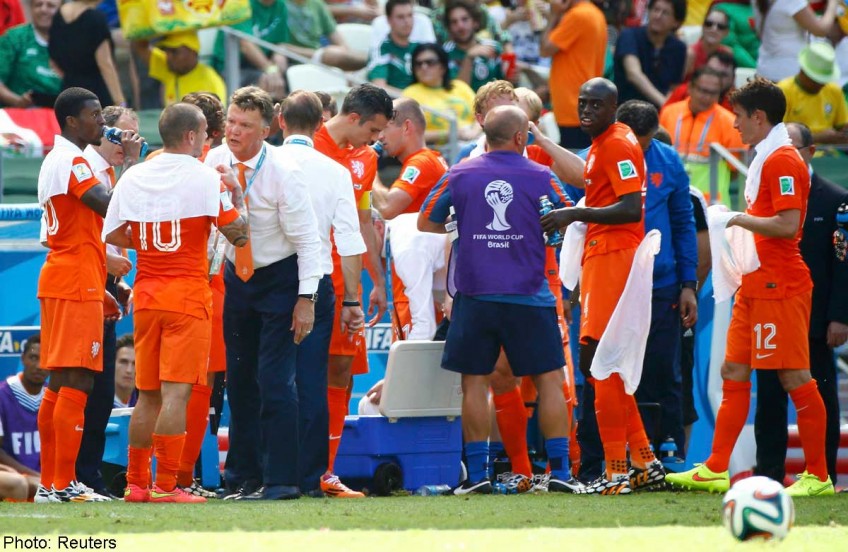Save lives, cancel Qatar


Reporting from Rio De Janerio
Holland's dramatic victory over Mexico proved two things.
The first is that Miguel Herrera's men suffered a cruel injustice at the hands of myopic Fifa organisers. And second, the World Cup 2022 tournament must be taken away from Qatar.
Lives are at risk. In its inexhaustible quest for global domination, the tournament could be left with blood on its hands; not only on the pitch but also in the stands.
Even mad dogs and Englishmen have avoided the midday sun here. Fortaleza is an insufferable, melanoma-baiting sauna. The temperature often tiptoes towards 40 deg C.
The Mexicans were the only unfortunate, sweat-soaked souls to play there twice.
Their group game against Brazil also kicked off in Fortaleza, where the collective lethargy was unmistakable.
The cagey contest ended 0-0. Mexican goalkeeper Guillermo Ochoa displayed the most creative energy only because he spent most of the game standing still.
Critics watching from afar have understandably marvelled at the Dutch coverage, Louis van Gaal's masterly tactical switches and Arjen Robben's penalty box impudence.
But geography played a pivotal part in Mexico's downfall.
Suffering a double punishment, they were the only team to succumb to Fortaleza's charmless sweatbox twice and faced the searing heat of Brazil's north-east in all four fixtures (Natal and Recife being the other locations.)
Robben's bald pate and Dirk Kuyt's red-headed genetics certainly left them exposed on the sun-soaked flanks, but the Dutch enjoyed a minor advantage before a ball had been kicked.
They had arrived from Sao Paulo, the chilliest city in the country, and had ventured north only once, in their Salvador opener against Spain, but that fixture wasn't played in midday.
The Mexicans were made to melt four times in a row.
On first inspection, Mexico coach Herrera's comments smacked of sour grapes, clearly at odds with the climate cliche involving European teams wilting in the tropics while sun-raised sides from the Americas thrived.
When asked if van Gaal's use of drinks breaks to make a tactical switch went against the spirit of the game, Herrera countered: "What goes against football is playing in this kind of climate.
"Neither team can give a worthy spectacle and you could see it in Holland, in the way that their rhythm and pace dropped in this temperature.
"You cannot play at the right level for 90 minutes."
Nor can you watch a game in that heat for 90 minutes.
Shaded
In the second half, the contest appeared to be played behind closed doors, with exposed fans in the lower tier fleeing to any shaded corners they could find to avoid the merciless sun.
In their wisdom, World Cup organisers scheduled a midday game in an exposed stadium with inadequate shelter.
Fans inside the ground yet again played second fiddle to supporters sitting on their sofas.
Only, on this occasion, the unsightly spectacle didn't look particularly appealing on TV either.
As its weather indicator, Fifa uses the lavishly-named Wet Bulb Globe Temperature - a series of measurements used to estimate the effect of temperature, humidity and wind speed. If the indicator exceeds 32 deg C, cooling breaks can take place.
The Dutch and Mexican players toiled in 38.8 deg C. Fortaleza's bowl-shaped arena trapped the heat. They were fried alive. Conditions went beyond dangerous. They were objectionable; practically contemptible.
In Qatar, the thermometer can hit 50 deg C between May and September. Cooling breaks may be less relevant than stretchers and waiting ambulances.
Yesterday, Fifa released a media statement that said: "Official and mandatory cooling breaks have not been established for the 64 games of the 2014 Fifa World Cup Brazil, but instead they will be considered on a match-by-match basis."
Questionable
By that rationale, every match in Qatar will consist of 90 minutes of cooling breaks with three minutes of football played in each half.
Before the Mexico game, van Gaal was warned that players were at risk of hallucinating without water breaks.
But they endured, mostly through their coach's astute tinkering but also because they had ventured to the refreshing, cooler climes of Sao Paulo and Porto Alegre.
Unfortunately, the fort of unremitting sunlight now awaits Brazil and Colombia.
The hosts return to the stadium that sapped the spirit against Mexico. Being an evening game, the quarter-final's conditions will cool in the second half.
But the first 45 minutes will be unbearable.
Ironically, the Selecao's oldest rivals have the most fortuitous route to Rio.
Argentina can expect a comfortingly chilly reception against Switzerland in Sao Paulo, before moving on to Brasilia, Sao Paulo again and then Rio's Maracana, should they prevail.
Brasilia is the furthest they venture north for a possible quarter-final date, but the inland capital is a veritable refrigerator compared to the sweaty cities on the exposed east coast.
The sun always shines on TV when Brazil are playing, but they won't want it to. The thermometer favours La Albiceleste.
But it doesn't favour Qatar. Fortaleza has raised a white flag to the ludicrous decision to allow a tournament to die in the desert.
Fifa will surely reconvene to save not only the World Cup's integrity, but quite possibly the lives of supporters foolhardy enough to take on Qatar's temperatures.
Fans made their feelings clear when they held an impromptu referendum inside the stadium yesterday morning. Empty plastic seats spoke louder than a dozen Fifa platitudes.
Supporters voted with their feet. The heat is on to cancel Qatar.

This article was first published on JULY 1, 2014.
Get The New Paper for more stories.